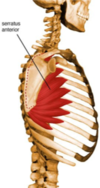Muscle Anatomy Flashcards
(30 cards)
Origin and insertion of latissimus dorsi?
Origin: spinous process of T7 to LV and sacrum, iliac crest, ribs 10 to 12 Inserts: floor or intertubercular sulcus of humerus (anterior aspect of humerus) Posterior origin to anterior insertion
What movement does the lat dorsi allow?
- Extends humerus
- Adducts humerus
- Medially rotates humerus
Posterior origin to anterior insertion
Innervation of lat dorsi?
Thoracodorsal nerve (C6 to C8)
Photo of lat dorsi
f

Origin of pec major?

2 parts; clavicular and sternocostal part
Clavicular part: originates from anterior surface of medial 1/2 of clavicle
Sternocostal part: originates from anterior surface of sternum and costal cartilage of ribs 1-6
Insertion of pec major?
Both clavicular and sternocostal parts have same insertion point –> inserts on the (bicipital groove and deltoid tuberosity of the) humerus
I.e. clavicle and sternum to arm
What movement does the pec major allow?
- Flexion of humerus (e.g. throwing ball underhand) –> as clavicular fibres contract and pull humerus up
- Adduction of humerus (e.g. flapping arms) –> as fibres contract and pull the humerus towards the body
- Rotates humerus medially (e.g. arm wrestling)
Also keeps arm attached to trunk of body
Photo of pectoralis major

Origin of pec minor?

Anterior surface of ribs 3-5
Insertion of pec minor?
Coracoid process of scapula
I.e. ribs to shoulder blade
What movement does pec minor allow?
- Stabilises scapula
- Assists in protraction
- Pulls tip of shoulder down
- Retraction
- Elevates ribs for deep inspiration when shoulder girdle is fixed
Photo of pec minor

Origin and insertion of serratus anterior?

Origin: Lateral surfaces of ribs 1-8 or 9
Inserts: Costal surfaces of medial border of scapula
i.e. ribs to shoulder blade
What movement does serratus anterior allow?
- Protraction of scapula
- Assist in respiration when fixed shoulder girdle
Photo of serratus anterior

Origin and insertion of trapezius?

3 parts; superior, middle inferior trapezius
Extends from back of head and neck to shoulder.
Inserts:
- Lateral 1/3 of clavicle
- Acromion
- Spine of scapula
What movement does trapezius allow?
- Elevate scapula
- Retract scapula
- Depress scapula
Origin and insertion of levator scapulae?

Origin: Transverse processes of C1-C4 (cervical vertebrae in neck)
Inserts: Upper portion of medial border of scapula
Neck –> shoulder
Movement of levator scapulae?
Elevates scapula towards neck
Photo of levator scapulae

Origin and insertion of rhomboid major?

Origin: Spinous processes of T2-T5
Insertion: Medial border of scapula at spine of scapula
Origin and insertion of rhomboid minor?

Origin: Lower portion of ligamentum nuchae, spinous processes of CVII and TI
Inserts: Medial border of scapula at spine of scapula
What movement do the rhomboids allow?
Retraction of scapula (pulls it towards vertebral column)
Origin and insertion of deltoid?

Origin: Lateral 1/3 of Clavicle (clavicular part), Acromion (acromial part), Spine of Scapula (spinal part) - Mnemonic: ‘Deltoid helps you carry SACS’
Inserts: Deltoid tuberosity of humerus





